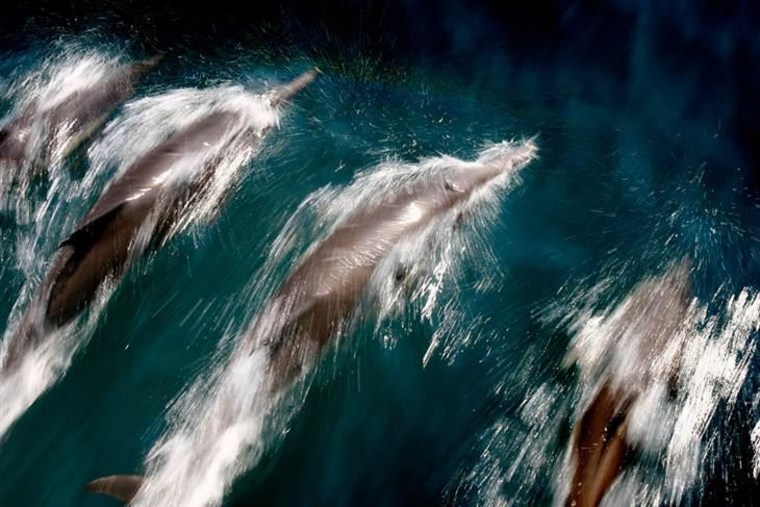A bite of puffer fish can paralyze and kill a human, but dolphins have been seen using the spiky lethal creatures as a chew toy, leading humans to wonder if the sea mammals were getting a buzz off the neurotoxin found in the fish.
Rob Pilley, a zoologist and producer on the crew of "Dolphin: Spy in the Pod" documentary, airing in the U.K. on BBC1, told the British Sunday Times, "This was a case of young dolphins purposely experimenting with something we know to be intoxicating ... After chewing the puffer gently and passing it round, they began acting most peculiarly, hanging around with their noses at the surface as if fascinated by their own reflection."
Dolphin researchers say they’ve yet to observe intoxicated dolphins in the wild. But, “it is very possible that dolphins are doing this,” Jason Bruck, a research fellow at the University of Chicago, who studies dolphin memories, wrote to NBC News in an email. After all, “there are examples of elephants getting drunk on fermented fruits.”
Dolphins participate in what human society might interpret as some pretty vile behavior — including murdering young dolphins, forcibly mating with female dolphins, and torturing sea life that they don't eat. So, sucking down a toxin that's 1,000 times as potent as potassium cyanide is well in keeping with the amoral world of nature.
But it could also be just another day in the dolphin pod — ignore the spiky lethal fish, and the behavior isn’t out of the ordinary. "We’ve observed dolphins pass fish around in normal play behavior," Diana Reiss, a dolphin cognition researcher at Hunter College, told NBC News.
As for whether they were fascinated by their reflection in the water, "I can tell you that when they’re not intoxicated, they are also fascinated by their reflection," said Reiss, who has studied how dolphins understand identity after conducting mirror experiments with aquarium animals.
Dolphins have blowholes on the top of their heads, through which they breathe, so it’s also possible that they were simply coming up for air, she said, adding that she'd have to see the footage first hand to make sure.
The pufferfish toxin goes by the name tetrodotoxin, or TTX, and is produced by bacteria and stored in the liver. Some octopuses, amphibians and shellfish also harbor bacteria that manufacture the toxin.
Adventurous humans eat pufferfish, also called "fugu," but only after the fish is professionally cleaned and trace quantities or less of the toxin remain. A larger dose of the molecule kills slowly, numbing the lips and paralyzing the extremities, working inwards, finally shutting down the brain.
While the poisonous effects of TTX on human victims is well documented, neither Bruck nor Reiss are aware of research confirming the toxin’s potentially narcotic reaction of the dolphin nervous system.
This leaves the possibility that it doesn't have any effect on dolphins at all. Some animals have developed an immunity to the paralytic effect: some garter snakes have modified their molecular biology, all the better to eat the three species of newt living in western North America. Like the puffers, the amphibians defend themselves by dosing predators with TTX.
Reiss has not encountered any other instances of buzz-seeking behavior in dolphins, but she says “if it’s true, it’s incredibly interesting — because they’ve joined other large-brained species to use something to get something pleasurable,” she told NBC News.
The first episode of "Spy in the Pod" aired in the U.K. on Thursday. The series will air in the U.S. at an unannounced date in 2014.
